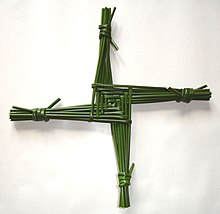
Brigid's cross or Brigit's cross (Irish: Cros Bhríde, Crosóg Bhríde or Bogha Bhríde) is a small variant of the Christian cross often woven from straw or rushes. It appears in many different shapes; the earliest designs were simple Christian Latin or Greek crosses, but the most popular modern iteration features a woven diamond or lozenge in the centre. The cross is named for the Christian saint Brigid of Kildare.
Brigid's cross is typically woven on 1 February, her feast day, as well as the festival of Imbolc in pre-Christian Ireland. Hanging Brigid's cross from the rafters of one's house was believed to bring the blessing and protection of the saint for the remainder of the year. The practice of crafting Brigid's crosses is first attested in the 17th century and seems to have been in decline by the 20th century, in part due to house renovations that made hanging them difficult.[1]
In addition to the shamrock and Celtic harp, Brigid's cross is a national symbol of Ireland. From 1962 to 1995, it was incorporated into the Raidió Teilifís Éireann logo. A collection of Brigid's crosses collected by the Irish Folklore Commission is on display at the National Museum of Ireland – Country Life.